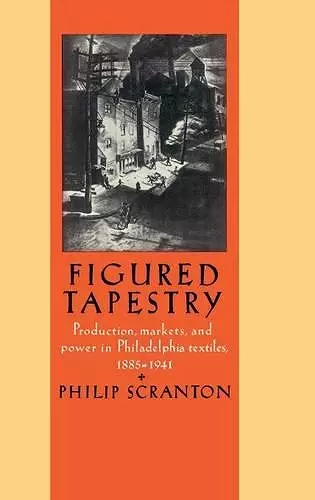Figured Tapestry
Production, Markets and Power in Philadelphia Textiles, 1855–1941
Format:Hardback
Publisher:Cambridge University Press
Published:28th Jul '89
Currently unavailable, and unfortunately no date known when it will be back
This hardback is available in another edition too:
- Paperback£34.99(9780521521369)

A study of industrial maturity and decline, focused on the Philadelphia textile trades.
Figured Tapestry is a study of industrial maturity and decline, focused on the Philadelphia textile trades from the era of the Knights of Labor through World War II. Scranton assesses the significance and limits of industrial versatility, owner-operated businesses, craft labor and its organizations, and the agglomeration of specialist mills in urban districts.Figured Tapestry is a study of industrial maturity and decline, focused on the Philadelphia textile trades from the era of the Knights of Labor through World War II. Unlike the bulk fabric enterprises of New England and the South, Quaker City textile firms were 'flexible specialists,' combining skilled labor, versatile technologies, and quick responsiveness to demand shifts to create a vast array of seasonal goods. Scranton assesses the significance and limits of industrial versatility, owner-operated businesses, craft labor and its organizations, and the agglomeration of specialist mills in urban districts. An interdisciplinary blend of business, labor, urban, and economic history, industrial geography, and the history of technology, Figured Tapestry illuminates the hidden world of batch production, the 'other side' of American industrialization, and highlights both the benefits and the hazards of flexibility, a matter of moment to those who seek to reorient current manufacturing away from the rigidities of mass production.
"[Scranton's] depiction of distinctive production formats and histories for different sectors and areas of the textile industry holds profound implications for understanding not only other American industries and industrial districts but also the process of industrial transformation itself." The Annals of American Academy
"Scranton has a really remarkable ability to draw upon the best recent perspectives in labor, business, technological, and social history without obscuring the perspective of the participants in the history he recounts." Judith A. McGaw, University of Pennsylvania
"In presenting the results of his prodigious research effort, Scranton has produced a book of 500 pages that is dense with facts and figures. It is without any doubt the definitive reference work on the subject. As in many detailed historical accounts, the sheer quantity and diversity of factual information that Scranton presents could have come at the expense of an analytical perspective. Fortunately, such is not the case here. Scranton's overriding perspective on the evolution of the Philadelphia textile region in the U.S. economy, as well as his understanding of the relations among economic, business, labor, and technological history at each stage of that evolution, make this book a masterpiece of historical analysis: that is, details do not just document the historical record; they serve an analytical purpose." William Lazonick, Journal of Economic History
ISBN: 9780521342872
Dimensions: 236mm x 161mm x 33mm
Weight: 908g
536 pages